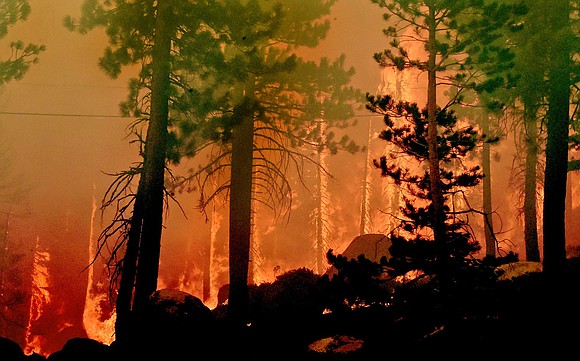Hospital patients are being evacuated as the rapidly growing Caldor Fire edges closer to California's Lake Tahoe region
CNN/Stylemagazine.com Newswire | 8/30/2021, 1:12 p.m.

Originally Published: 30 AUG 21 05:22 ET
Updated: 30 AUG 21 13:30 ET
By Joe Sutton and Hollie Silverman, CNN
(CNN) -- The raging Caldor Fire in Northern California prompted evacuation orders and warnings in the Lake Tahoe Basin Sunday night after fire conditions resulted in rapid spread, causing at least one hospital to transfer all of its patients out amid the flames.
All patients were being evacuated from Barton Memorial Hospital in South Lake Tahoe.
"Patients will be transferred to regional partner facilities & patients' families will be notified," the hospital said in a tweet Sunday night. "Barton's Emergency Department remains open for emergent health needs only."
Five people have been injured in the fire that has destroyed more than 650 structures and damaged nearly 40 more since it began August 14, Cal Fire said.
An evacuation order had been issued for some parts of Alpine and El Dorado counties, along with evacuation warnings for other parts of the counties, Cal Fire said in a news release.
The warning, which signifies that there is "a potential threat to life and/or property" was expanded for additional parts of the basin, Cal Fire said in an alert Sunday.
"Those who require additional time to evacuate and those with pets and livestock should leave now," the alert warned.
Victor Babbitt, a resident of Meyers in El Dorado County, said he was lucky to be able to get out when he did despite not receiving a formal notice to leave.
"I found out by a warning basically and that was it. No one came to the house," he told CNN affiliate KTVN. "The neighbors were all leaving ... we just packed everything up best we could and off we go."
The city of South Lake Tahoe asked residents to be prepared for the possibility of evacuations.
"The most important thing people can do now is get their go-bags ready and have a plan in place to evacuate should an evacuation order get extended," city spokeswoman Lindsey Baker told CNN.
The call for preparation came as the fire had an active day and worse conditions are expected this week, Clive Savacool, fire chief for the city of South Lake Tahoe, told KTVN.
"The Caldor Fire has made a pretty big jump in the last few hours, so that's had a pretty big impact on the community and expansion of evacuations," Savacool explained.
"It's because these winds, the low humidity, the low moisture, all these conditions are making it very, very treacherous for this fire and so that's why its been expanding so rapidly."
There was a "significant increase in dynamic fire behavior resulting in rapid fire spread," Sunday, according to Cal Fire
Inciweb's incident report on the Caldor Fire said the increase in spread was due largely to wind gusts between 25-35 mph and relative humidity between 10-15%.
Critical fire weather conditions are expected in the coming days, according to a tweet from the National Weather Service in Sacramento, with gusts of 20 to 35 mph possible in the afternoons and evenings.
The agency said in a tweet Sunday that smoke from the wildfires has created poor air quality across the region, with some locations in the hazardous category.
A red flag warning will be in place from Monday night until Tuesday as humidity values will run as low as 5-10%, according to CNN Meteorologist Michael Guy.
With an extreme drought and several active wildfires burning during the middle of the state's fire season, firefighters have had to pace themselves and outside resources have been called in.
Soldiers deployed to help with fire operations
The Caldor Fire grew to 177,260 acres and is 14% contained, Cal Fire said Monday, as the fire continued to "actively burn" overnight due to low humidity as it threatened South Lake Tahoe. Officials Sunday evening listed the fire at 168,387 acres and 13% contained.
"Low humidity remained poor overnight and allowed the fire to continue to actively burn," according to an incident update. "Fire weakened trees continue to present a risk for crews."
It is one of several fires burning in California where more than 1.6 million acres have been scorched this year alone, the Cal Fire website shows.
Not only has it prompted evacuations for residents but it has also closed at least two local resorts.
Kirkwood Mountain Resort said in a message Sunday that it is under a mandatory evacuation.
And the Heavenly Ski Resort said on Twitter earlier this month, "Due to ongoing risk of wildfire to the Tahoe Region, Heavenly is now closed for summer."
Wildfires in the state have gotten so intense that approximately 200 Army Soldiers will be deployed at the request of the National Interagency Fire Center (NIFC) to assist with firefighting operations starting Monday, a statement from US Army North Public Affairs said.
Units from Joint Base Lewis-McChord (JBLM) in Washington state will be trained to assist with the response to the Dixie Fire which is burning on National Parks land, the release said.
The largest active wildfire in the state, the Dixie Fire, has grown to more than 765,635 acres since igniting in mid-July, according to Cal Fire.
"Upon completion of training at JBLM, the Soldiers will deploy to Northern California to conduct additional fireline training prior to serving as hand crews assisting with wildfire suppression on the Dixie Fire," the Army statement said.






